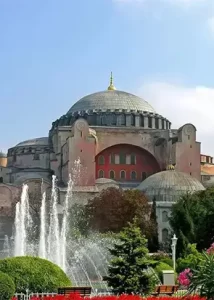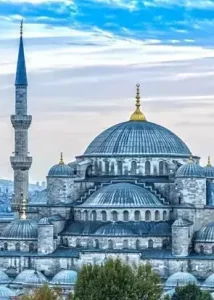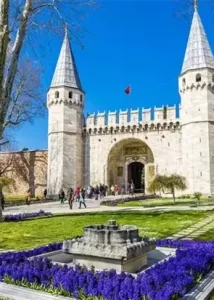Tour Details:
Istanbul Old City Tour is a full day group tour includes licenced tour guide, lunch and hotel pick-drop off from city center hotels.
Travel by Turkey higly recommend Istanbul Old City Tour if you want to discover old city Istanbul, save money and time with our licenced tour guide. You can skip the line of museums with our official tour guides.
Note: Topkapi Palace Museum is closed on tuesday. It is replaced with Basilica Cistern Museum.
Tour Program:
- Hagia Sophia Mosque
- Sultanahmet Mosque(Blue Mosque)
- Hippodrome
- Lunch
- Topkapi Palace Museum
- Harem
- Hagia Irene Church
- Shopping
- Grand Covered Bazaar(closed on sunday)
What is included?
- Pick up-drop off from city center hotels
- Licenced tour guide
- Fully Air-Conditioned Vehicle
- Walking Tour
- Lunch
What is not included?
- Self expenses
- Drinks
- Tips
- Entrance Fees (Topkapi entrance is 45 Euro and Hagia Sophia 25 Euro)
Cancellation Policy
- If you cancel up to 24 hours in advance of the experience, you will receive full refund.
- When you cancel less than 24 hours before start time, you will not be refunded.
- If you want any changes less than 24 hours before start time, it will not be accepted.
- If the tour canceled due to poor weather, we will offer a different date or a full refund.
ISTANBUL OLD CITY TOUR
What to Expect?
Hagia Sophia:
Hagia Sophia, located in Istanbul, Turkey, is a historic architectural marvel with a rich and diverse history. Originally built as a cathedral in 537 under the Byzantine Emperor Justinian I, it served as the primary church of the Eastern Orthodox Church for nearly a thousand years. Following the Ottoman conquest of Constantinople in 1453, Hagia Sophia was converted into a mosque by Sultan Mehmed II.
Hagia Sophia is renowned for its impressive dome, intricate mosaics, and a synthesis of Byzantine and Ottoman architectural elements. The structure symbolizes the cultural and religious transitions that occurred in the region over the centuries. In 1935, under the Republic of Turkey, Hagia Sophia was secularized and transformed into a museum by Mustafa Kemal Atatürk. However, in 2020, it was once again designated as a mosque, sparking discussions about its status as both a cultural monument and a place of worship. The Hagia Sophia stands as a testament to Istanbul’s diverse history, representing both Christian and Islamic influences over the centuries.
Blue Mosque:
The Blue Mosque, officially known as the Sultan Ahmed Mosque, is a prominent historical mosque located in Istanbul, Turkey. Commissioned by Sultan Ahmed I and completed in 1616, the mosque is renowned for its stunning architecture and a distinctive feature of its six minarets, a rare design choice at the time. The name “Blue Mosque” is derived from the blue tiles that adorn the interior, creating a mesmerizing visual effect. The mosque is a significant landmark in Istanbul, situated near the Hagia Sophia and facing the historic Hippodrome. With its cascading domes, elegant minarets, and expansive courtyard, the Blue Mosque is a symbol of Ottoman architectural grandeur and an active religious site that welcomes visitors from around the world.
Hippodrome:
The Hippodrome of Constantinople, located in present-day Istanbul, Turkey, was a chariot racing and entertainment venue that served as the center of civic life during the Byzantine Empire. Originally constructed by Roman Emperor Septimius Severus in AD 203, it underwent several renovations over the centuries. The Hippodrome was adorned with various monuments, including the Obelisk of Theodosius, the Serpent Column, and the Walled Obelisk, contributing to its grandeur. It hosted chariot races, ceremonies, and public gatherings, playing a crucial role in the social and political life of Constantinople. Despite being largely destroyed over time, remnants of the Hippodrome’s structures and monuments can still be seen in Istanbul today, offering a glimpse into the city’s rich historical past.
Topkapi Palace Museum:
The Topkapi Palace Museum, situated in Istanbul, Turkey, was the primary residence of the Ottoman Sultans for nearly 400 years. Constructed in the 15th century by Mehmed the Conqueror, the palace served as the administrative and ceremonial center of the Ottoman Empire. The palace complex consists of various courtyards, halls, and pavilions, showcasing exquisite examples of Ottoman architecture and design.
The museum houses an extensive collection of artifacts, including imperial costumes, manuscripts, weapons, and religious relics. One of the notable exhibits is the Imperial Harem, offering insights into the private lives of the Ottoman rulers. The Topkapi Palace Museum provides visitors with a captivating journey through the opulent history of the Ottoman Empire and its cultural and artistic heritage. The breathtaking views of the Bosphorus and the Golden Horn from the palace further enhance its allure.
Hagia Irene Church:
Hagia Irene, located in Istanbul, Turkey, is an ancient church with a rich history. Originally constructed by the Roman Emperor Constantine I in the 4th century, it is one of the oldest churches in Istanbul. Hagia Irene served various purposes over the centuries, functioning as a church, arsenal, and museum at different times.
The church is characterized by its simple yet elegant architecture, featuring a basilica design with a central nave and two side aisles. Unlike its more famous counterpart, Hagia Sophia, Hagia Irene retains much of its original structure without significant alterations.
Despite being a significant historical and cultural site, Hagia Irene is often less visited than other nearby landmarks. The church’s historical importance, coupled with its serene atmosphere and architectural beauty, makes it a compelling destination for those interested in Istanbul’s rich past.
Grand Covered Bazaar(closed on Sunday):
The Grand Bazaar, located in the heart of Istanbul, Turkey, is one of the world’s oldest and largest covered markets. Constructed in the 15th century during the Ottoman Empire, the Grand Bazaar is an iconic symbol of Istanbul’s historical and commercial heritage.
Spread across numerous covered streets, the Grand Bazaar is a labyrinthine complex comprising over 4,000 shops and stalls. It offers a diverse array of goods, including Turkish carpets, textiles, jewelry, ceramics, spices, and traditional handicrafts. The market is renowned for its vibrant atmosphere, with shopkeepers engaging in the art of bargaining, creating a dynamic and bustling experience for visitors.
The architecture of the Grand Bazaar is characterized by its domed roofs, arched passageways, and intricately decorated facades. The market not only serves as a hub for commerce but also as a cultural and social center, reflecting the city’s historical and multicultural influences. A visit to the Grand Bazaar provides a captivating journey into Istanbul’s past and a chance to explore its vibrant present-day commercial life.





